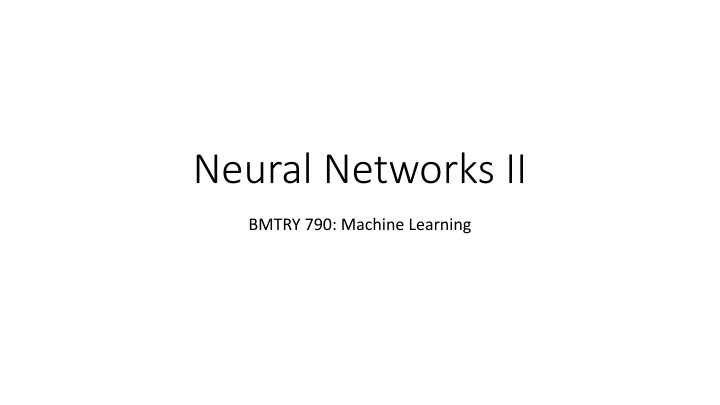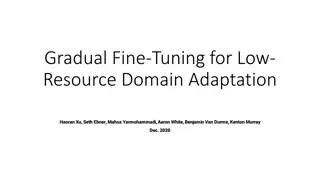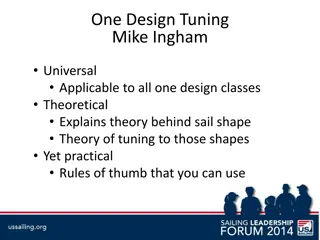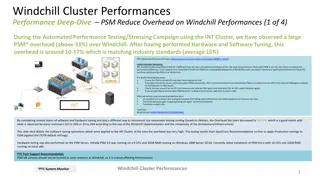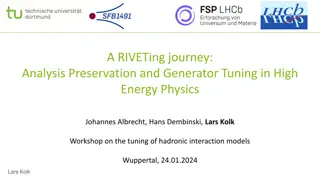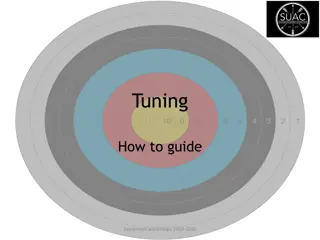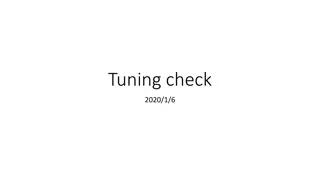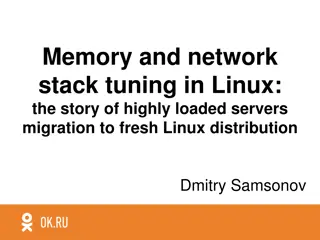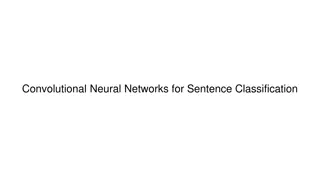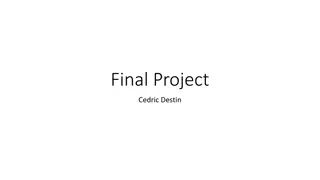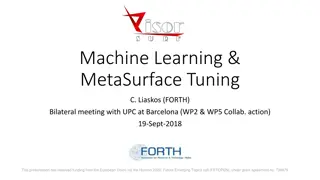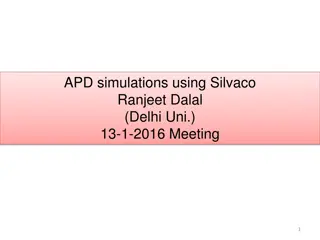Tuning ANNs for Improved Performance
ANNs face challenges like over-parameterization and non-convex optimization. Learn how to optimize ANN models with considerations in starting values, avoiding overfitting, and selecting hidden units. Discover the impact of starting values, likelihood of overfitting, weight decay, and scaling inputs for enhanced performance.
Download Presentation

Please find below an Image/Link to download the presentation.
The content on the website is provided AS IS for your information and personal use only. It may not be sold, licensed, or shared on other websites without obtaining consent from the author.If you encounter any issues during the download, it is possible that the publisher has removed the file from their server.
You are allowed to download the files provided on this website for personal or commercial use, subject to the condition that they are used lawfully. All files are the property of their respective owners.
The content on the website is provided AS IS for your information and personal use only. It may not be sold, licensed, or shared on other websites without obtaining consent from the author.
E N D
Presentation Transcript
Neural Networks II BMTRY 790: Machine Learning
Tuning ANNs There are several considerations when fitting an ANN model Models tend to be over-parameterized Optimization is non-convex and unstable However, there is some guidance on how to address these issues Choosing starting weights Avoiding overfitting Choosing number of hidden units and layers
Impact of Starting Values Recall, in fitting a feed-forward ANN, we must initialize the weights we will consider in the model Have weights mjfor each predictor Xjfor hidden unit Zm Also have weights kmfor hidden unit Zmon outcome Yk If weights are initialized near 0 and the sigmoidal function is used Operative part of sigmoid function is approximately linear Thus ANN is initially approximately linear Note becomes less linear as weights increase (i.e. algorithm proceeds) Thus common choice is to randomly initialize starting weights near 0
Likelihood of Over-fitting ANNs are particularly prone to over-fitting Use of many weights allows algorithm to achieve a global minimum However this results in model that is not generalizable Early ANNs employed an early stopping rule to avoid this issue Starting weights already represent a highly regularized solution (all near 0) Use validation set to determine when to stop Weight decay is a more formalized method of regularization Add a penalty term to the error function (think ridge and lasso)
Weight Decay As I mentioned, weight decay formalized the idea of regularization by including a penalty in the error function. ( ) R ( ) + J Several J( ) have been proposed ( ) = + 2 km 2 ml J (like ridge penalty) km ml + + 2 km 2 ml ( ) = + J (weight elimination) 2 km 2 ml 1 1 km ml is a shrinkage parameter and needs to be chosen when tuning the models
Scaling Inputs When using a regularization approach, scale of the inputs impacts the scaling of the weights in the bottom layer (i.e. Xj s) Just as with ridge or lasso regression, it is a good idea to center and scale all continuous predictors Ensures inputs treated equally in regularization Also provides a more informed choice of starting weights Note with standardized inputs, input weights typically initialized between -0.7 and 0.7.
Number of Hidden Units and Layers The hidden units can be thought of as latent variables Estimated as a non-linear function applied to a weighted linear combination of original inputs Xj We don t know up front how many hidden units to use Too few yields a model that isn t necessarily sufficiently flexible Too many can overfit (but this can be addressed by regularization) Typical good choice ranges between 5 to 100 We can also have multiple hidden layers Allows for construction of hierarchical features with different levels resolution Generally chosen by background knowledge and/or experimentation
Bagged ANNs Because the error function is non-convex, there are often many local minima As a results, the final solution is often very dependent on the choice of starting weights Could try different starting weights to choose ones that yields the smallest error Alternatively, average prediction over a collection of neural networks Popular fix is to build a bagged ANN and make predictions much as we would from a bagged set of decision trees
Fitting ANNs in R As with many of the methods we ve discussed, there are several packages to fit ANN models in R nnet: can fit ANN for regression and binary or multi-class outcomes but can only consider a single hidden later neuralnet: fits ANNs for regression or binary outcomes (not multi-class), can consider multiple hidden layers RSNNS: Implements the Stuttgart Neural Network Simulator to fit mulit- layer perceptrons Others with differing functionality FCNN4R, brnn, elm Let s look at some examples
Lupus Nephritis Example: Treatment response in patients with treatment response Data include 213 observations examining treatment response at 1 year in patient with lupus nephritis Data includes Demographics: Treatment response: Clinical Markers: Urine markers: age, race Yes/No c4c, dsDNA, EGFR, UrPrCr IL2ra, IL6, IL8, IL12
nnet Package ######################################################### ### 2-CLASS CLASSIFICATION EXAMPLE ### TREATMENT RESPONSE IN LUPUS NEPHRITIS ######################################################### LN<-read.csv("H:/public_html/BMTRY790_Spring2023/Datasets/LupusNephritis.csv") ids1<-which(LN$CR90==1) ids0<-which(LN$CR90==0) LN[,c(2,3,5:10)]<-scale(LN[,c(2,3,5:10)]) set.seed(1234) trn1<-sample(ids1, .67*length(ids1), replace=F) trn0<-sample(ids0, .67*length(ids0), replace=F) sub<-sort(c(trn1, trn0)) ### ###
nnet Package #### Fitting an ANN using nnet (as always, train the model first) tngrid<-expand.grid(size=c(5,10,20,30,40,50), decay=c(0.05,0.1,0.5)) trnnet<-train(as.factor(CR90) ~ ., data=LN, method="nnet", trControl=trainControl(method="cv", number=10), tuneGrid=tngrid) trnnet Neural Network 280 samples 10 predictor 2 classes: '0', '1' No pre-processing Resampling: Cross-Validated (10 fold) Summary of sample sizes: 253, 252, 251, 252, 252, 252, ... Resampling results across tuning parameters: size decay Accuracy Kappa 5 0.05 0.7362114578 0.2484269312 50 0.50 0.7396871009 0.1741686209 Accuracy was used to select the optimal model using the largest value. The final values used for the model were size = 30 and decay = 0.5.
nnet Package nnmod1<-nnet(as.factor(CR90)~., data=LN[sub,], size=30, decay=0.5, maxit=100) # weights: 361 initial value 145.618573 iter 10 value 102.555621 iter 20 value 100.058072 iter 100 value 99.704650 final value 99.704650 stopped after 100 iterations name(nnmod1) [1] "n" "nunits" "nconn" "conn" "nsunits" "decay" "entropy" "softmax" [9] "censored" "value" "wts" "convergence" "fitted.values" "residuals" "lev" [16] "call" "terms" "coefnames" "xlevels
nnet Package nnmod1$n [1] 10 30 1 nnmod1$conn [1] 0 1 2 3 4 5 6 7 8 9 10 0 1 2 3 4 5 6 7 8 9 10 0 1 2 3 4 5 6 . [320] 0 1 2 3 4 5 6 7 8 9 10 0 11 12 13 14 15 16 17 18 19 20 21 22 23 24 [346] 25 26 27 28 29 30 31 32 33 34 35 36 37 38 39 40 nnmod1$nconn [1] 0 0 0 0 0 0 0 0 0 0 0 0 11 22 33 44 55 66 77 88 99 110 121 132 [25] 143 154 165 176 187 198 209 220 231 242 253 264 275 286 297 308 319 330 361
nnet Package nnmod1$conn [1] 0 1 2 3 4 5 6 7 8 9 10 0 1 2 3 4 5 6 7 8 9 10 0 1 2 3 4 5 6 . [346] 25 26 2728 29 30 31 32 33 34 35 36 37 38 39 40 round(nnmod1$wts, 3) [1] 0.0005 0.0593 -0.0274 0.1914 0.0048 0.0126 -0.0672 -0.1933 0.0043 0.1039 [11] 0.0475 0.0007 0.0596 -0.0272 0.1915 0.0050 0.0127 -0.0675 -0.1934 0.0043 [21] 0.1039 0.0475 -0.0011 -0.0449 0.0198 -0.1538 -0.0062 -0.0050 0.0527 0.1567 [331] -0.0108 -0.3221 -0.3223 0.2515 -0.3220 0.2513 0.2533 -0.3222 -0.3218 -0.3222 [341] 0.2534 -0.3218 -0.3219 -0.3221 -0.3222 0.2508 -0.3223 -0.3220 -0.3220 0.2520 [351] 0.2521 -0.3221 -0.3221 -0.3222 0.2517 -0.3223 1.2524 0.2509 -0.3222 0.2518 [361] -0.3220
nnet Package as.vector(round(nnmod1$fitted.values, 4) ) [1] 0.0969 0.0278 0.2560 0.2994 0.5586 0.4812 0.5789 0.0705 0.1871 0.1420 0.2554 0.3335 [13] 0.1053 0.2074 0.3109 0.2626 0.0865 0.1295 0.1657 0.1888 0.6342 0.3201 0.3520 0.2059 [181] 0.1471 0.1609 0.3060 0.3666 0.1803 0.2321 0.5551 table(ifelse(nnmod1$fitted.values<0.5, 0, 1), LN$CR90[sub]) 0 1 0 136 42 1 2 7 table(ifelse(predict(nnmod1, newdata=LN[-sub,])>0.5, 1, 0), LN$CR90[-sub]) 0 1 0 68 23 1 0 2
nnet Package ### Another way to look at it library(pROC) trroc<-roc(LN$CR90[sub], as.vector(nnmod1$fitted.values)) trroc Call: roc.default(response = LN$CR90[sub], predictor = as.vector(nnmod1$fitted.values)) Data: as.vector(nnmod1$fitted.values) in 138 controls (LN$CR90[sub] 0) < 49 cases (LN$CR90[sub] 1). Area under the curve: 0.7333629 tsroc<-roc(LN$CR90[-sub], as.vector(predict(nnmod1, newdata=LN[-sub,]))) tsroc Call: roc.default(response = LN$CR90[-sub], predictor = as.vector(predict(nnmod1, newdata = LN[-sub, ]))) Data: as.vector(predict(nnmod1, newdata = LN[-sub, ])) in 68 controls (LN$CR90[-sub] 0) < 25 cases (LN$CR90[-sub] 1). Area under the curve: 0.7523529
RSNNS Package #### Using the RSNNS package (first train the model) library(RSNNS) tngrid<-expand.grid(layer1=3:5, layer2=1:4, layer3=0:3, decay=c(0.1, 0.2)) trnnet<-train(as.factor(CR90) ~ ., data=LN, maxit=200, method="mlpWeightDecayML", trControl=trainControl(method="cv", number=10), tuneGrid=tngrid) Multi-Layer Perceptron, multiple layers 280 samples; 10 predictor; 2 classes: '0', '1' No pre-processing Resampling: Cross-Validated (10 fold) Summary of sample sizes: 251, 251, 252, 252, 253, 251, ... Resampling results across tuning parameters: layer1 layer2 layer3 decay Accuracy Kappa 3 0 0 0.1 0.7358921730 0 3 0 0 0.2 0.5895958767 0 5 4 4 0.1 0.7358921730 0 5 4 4 0.2 0.6429164386 0 Accuracy was used to select the optimal model using the largest value. The final values used for the model were layer1 = 3, layer2 = 1, layer3 = 0 and decay = 0.1.
RSNNS Package #### Using the RSNNS package (first train the model) nnmod2<-mlp(x=LN[sub,-11], LN$CR90[sub], size=c(3,1), learnFuncParams=c(0.1), maxit=500, linOut=FALSE, inputsTest=LN[-sub,-11], targetsTest=LN[-sub,11]) par(mfrow=c(2,2)) plotIterativeError(nnmod2) predictions <- predict(nnmod2,LN[-sub,-11]) plotRegressionError(predictions[,1], LN[-sub,11]) plotROC(fitted.values(nnmod2), LN[sub,11]) plotROC(predictions, LN[-sub,11])
nnmod2a<-mlp(x=LN[sub,-11], LN$CR90[sub], size=c(3,1), learnFuncParams=c(0.1), maxit=250, linOut=FALSE, inputsTest=LN[-sub,-11], targetsTest=LN[-sub,11])
RSNNS Package > roc(LN$CR90[sub], as.vector(predict(nnmod2a))) Setting levels: control = 0, case = 1 Setting direction: controls < cases Call: roc.default(response = LN$CR90[sub], predictor = as.vector(predict(nnmod2a))) Data: as.vector(predict(nnmod2a)) in 138 controls (LN$CR90[sub] 0) < 49 cases (LN$CR90[sub] 1). Area under the curve: 0.7786 > roc(LN$CR90[-sub], as.vector(predict(nnmod2a, newdata=LN[-sub,-11]))) Setting levels: control = 0, case = 1 Setting direction: controls < cases Call: roc.default(response = LN$CR90[-sub], predictor = as.vector(predict(nnmod2a, newdata = LN[-sub, -11]))) Data: as.vector(predict(nnmod2a, newdata = LN[-sub, -11])) in 68 controls (LN$CR90[-sub] 0) < 25 cases (LN$CR90[-sub] 1). Area under the curve: 0.7182 table(ifelse(nnmod1$fitted.values<0.5, 0, 1), LN$CR90[sub]) 0 1 0 124 32 1 14 17 table(ifelse(predict(nnmod1, newdata=LN[-sub,])>0.5, 1, 0), LN$CR90[-sub]) 0 1 0 63 19 1 5 6
RSNNS Package unit definition section : no. | typeName| unitName | act | bias | st | position | act func | out func | sites ----|----------|---------------------|-------------|-------------|----|---------- |-----------------|----------|------- 1 | | Input_race | 1.00000 | 0.14227 | i | 1, 0, 0 | Act_Identity| | 2 | | Input_age | -0.29287 | 0.02396 | i | 2, 0, 0 | Act_Identity| | 3 | | Input_urprcr | -0.70644 | -0.14502 | i | 3, 0, 0 | Act_Identity| | 4 | | Input_dsdnapn | 1.00000 | 0.24410 | i | 4, 0, 0 | Act_Identity| | 5 | | Input_c4c | -0.45356 | 0.21352 | i | 5, 0, 0 | Act_Identity| | 6 | | Input_egfr | -0.02096 | -0.12572 | i | 6, 0, 0 | Act_Identity| | 7 | | Input_il2ra | 1.88319 | -0.19338 | i | 7, 0, 0 | Act_Identity| | 8 | | Input_il6 | 0.54756 | -0.22156 | i | 8, 0, 0 | Act_Identity| | 9 | | Input_il8 | -0.06250 | -0.23556 | i | 9, 0, 0 | Act_Identity | | 10 | | Input_il12 | -0.48901 | -0.15669 | i | 10, 0, 0 | Act_Identity| | 11 | | Hidden_2_1 | 0.99061 | 0.25627 | h | 1, 2, 0 ||| 12 | | Hidden_2_2 | 0.68652 | 0.00629 | h | 2, 2, 0 ||| 13 | | Hidden_2_3 | 0.02644 | -0.34849 | h | 3, 2, 0 ||| 14 | | Hidden_3_1 | 0.33832 | 0.42794 | h | 1, 4, 0 ||| 15 | | Output_1 | 0.39277 | 0.87233 | o | 1, 6, 0 ||| ----|----------|---------------------|-------------|-------------|----|------------|-------------------|----------|-------
RSNNS Package > extractNetInfo(nnmod2a)$unitDefinitions unitNo unitName unitAct unitBias type posX posY posZ actFunc outFunc sites 1 1 Input_race 1.00000000 0.142274946 UNIT_INPUT 1 0 0 Act_Identity Out_Identity 2 2 Input_age -0.29286540 0.023958683 UNIT_INPUT 2 0 0 Act_Identity Out_Identity 3 3 Input_urprcr -0.70644116 -0.145024896 UNIT_INPUT 3 0 0 Act_Identity Out_Identity 4 4 Input_dsdnapn 1.00000000 0.244095743 UNIT_INPUT 4 0 0 Act_Identity Out_Identity 5 5 Input_c4c -0.45356163 0.213524163 UNIT_INPUT 5 0 0 Act_Identity Out_Identity 6 6 Input_egfr -0.02096219 -0.125717014 UNIT_INPUT 6 0 0 Act_Identity Out_Identity 7 7 Input_il2ra 1.88318801 -0.193376452 UNIT_INPUT 7 0 0 Act_Identity Out_Identity 8 8 Input_il6 0.54756421 -0.221560270 UNIT_INPUT 8 0 0 Act_Identity Out_Identity 9 9 Input_il8 -0.06250137 -0.235559404 UNIT_INPUT 9 0 0 Act_Identity Out_Identity 10 10 Input_il12 -0.48900744 -0.156690210 UNIT_INPUT 10 0 0 Act_Identity Out_Identity 11 11 Hidden_2_1 0.99060601 0.256269306 UNIT_HIDDEN 1 2 0 Act_Logistic Out_Identity 12 12 Hidden_2_2 0.68652302 0.006293331 UNIT_HIDDEN 2 2 0 Act_Logistic Out_Identity 13 13 Hidden_2_3 0.02643615 -0.348486125 UNIT_HIDDEN 3 2 0 Act_Logistic Out_Identity 14 14 Hidden_3_1 0.33832175 0.427941352 UNIT_HIDDEN 1 4 0 Act_Logistic Out_Identity 15 15 Output_1 0.39276898 0.872330725 UNIT_OUTPUT 1 6 0 Act_Logistic Out_Identity
RSNNS Package > round(weightMatrix(nnmod2a)[,c(1,10:15)], 3) Input_race Input_il12 Hidden_2_1 Hidden_2_2 Hidden_2_3 Hidden_3_1 Output_1 Input_race 0 0 -0.093 0.423 0.106 0.000 0.000 Input_age 0 0 -0.585 -0.288 0.166 0.000 0.000 Input_urprcr 0 0 -2.672 1.171 1.419 0.000 0.000 Input_dsdnapn 0 0 0.203 -0.212 -0.917 0.000 0.000 Input_c4c 0 0 -0.558 -0.922 0.378 0.000 0.000 Input_egfr 0 0 -0.534 -1.799 -1.008 0.000 0.000 Input_il2ra 0 0 0.978 0.303 -0.656 0.000 0.000 Input_il6 0 0 0.014 0.691 -0.184 0.000 0.000 Input_il8 0 0 -0.626 -1.304 -0.088 0.000 0.000 Input_il12 0 0 -0.165 0.364 -0.175 0.000 0.000 Hidden_2_1 0 0 0.000 0.000 0.000 -2.801 0.000 Hidden_2_2 0 0 0.000 0.000 0.000 2.371 0.000 Hidden_2_3 0 0 0.000 0.000 0.000 1.812 0.000 Hidden_3_1 0 0 0.000 0.000 0.000 0.000 -3.866 Output_1 0 0 0.000 0.000 0.000 0.000 0.000
Plotting and ANN form RSNNS ### NICE plots of ANN model from RSNNS library(NeuralNetTools) plotnet(nnmod2a)
Bagged ANN We already know bagging is one approach to improve prediction performance of weak learners The caret package has functionality to fit a bagged ANN model using models from the nnet package as the base models We can train this model using the train function in caret We could also easily develop a function to fit a bagged ANN using the RSNNS package which has greater functionality.
Bagged ANN ### Using the avNNet function from caret to fit a bagged neural net tngrid<-expand.grid(size=c(5,25,50), decay=c(0.1,0.5), bag=c(100,150,200,250)) trnnet<-train(as.factor(CR90) ~ ., data=LN, method="avNNet", trControl=trainControl(method="cv", number=10), tuneGrid=tngrid) trnnet Model Averaged Neural Network 280 samples 10 predictor .. Resampling results across tuning parameters: size decay bag Accuracy Kappa 5 0.1 100 0.7538405400 0.2397554221 50 0.5 250 0.7498722861 0.1826383057 Accuracy was used to select the optimal model using the largest value. The final values used for the model were size = 25, decay = 0.5 and bag = 150.
Bagged ANN ### Using the avNNet function from caret to fit a bagged neural net nnmod3<-avNNet(as.factor(CR90)~., data=LN[sub,], size=25, decay=0.5, repeats=250, bag=TRUE) round(predict(nnmod3),3) 0 1 220 0.648 0.352 178 0.603 0.397 2 0.600 0.400 225 0.617 0.383 27 0.608 0.392 28 0.622 0.378 56 0.605 0.395 233 0.640 0.360 231 0.595 0.405 209 0.567 0.433 75 0.615 0.385
Bagged ANN ### Using the avNNet function from caret to fit a bagged neural net table(predict(nnmod3, newdata=LN[sub,-11], type="class"), LN$CR90[sub]) 0 1 0 137 44 1 1 5 table(predict(nnmod3, newdata=LN[-sub,-11], type="class"), LN$CR90[-sub]) 0 1 0 68 23 1 0 2
Bagged ANN trroc<-roc(LN$CR90[sub], predict(nnmod3, newdata=LN[sub,-11], type="prob")[,2]) trroc Call: roc.default(response = LN$CR90[sub], predictor = predict(nnmod3, newdata = LN[sub, -11], type = "prob")[, 2]) Data: predict(nnmod3, newdata = LN[sub, -11], type = "prob")[, 2] in 138 controls (LN$CR90[sub] 0) < 49 cases (LN$CR90[sub] 1). Area under the curve: 0.7248 tsroc<-roc(LN$CR90[-sub], predict(nnmod3, newdata=LN[-sub,-11], type="prob")[,2]) tsroc Call: roc.default(response = LN$CR90[-sub], predictor = predict(nnmod3, newdata = LN[-sub, -11], type = "prob")[, 2]) Data: predict(nnmod3, newdata = LN[-sub, -11], type = "prob")[, 2] in 68 controls (LN$CR90[-sub] 0) < 25 cases (LN$CR90[-sub] 1). Area under the curve: 0.7565
Multinomial Example Localized breast cancer can be treated by excising tumor tissue in the affected breast In order to ensure removal of as little tissue as possible, it is important to determine different tissue types to discriminate tumor from other tissue. Study goal: Determine if impedence measures in human breast tissue can discriminate Connective Benign tumor Carcinoma Adipose
Multinomial Example Features: I0 = Impedivity (ohm) at zero frequency PA500 = Phase angle at 500 KHz HFS = High-frequency slope of phase angle normArea = Area under the spectrum by impedance distance between spectral ends Max IP = Maximum of the spectrum DR = Distance between I0 and the real part of the maximum frequency point P = Length of the spectral curve
RSNNS Package ###################################################### ### Example of Multi-Class ANN model ### ### MULTI-CLASS CLASSIFICATION EXAMPLE ### DIFFERENTIATING BREAST TISSUE TYPES ### ###################################################### ### ### ### #### Using the RSNNS package (first train the model) btis<-read.csv("H:\\public_html\\BMTRY790_Spring2023\\Datasets\\BreastTissue.csv") btis<-btis[,-1] set.seed(1234) sub<-sort(sample(1:nrow(btis), 0.67*nrow(btis), replace=F)) tngrid<-expand.grid(layer1=0:5, layer2=0:5, layer3=0:5, decay=c(0.1, 0.2)) trnnet<-train(Class ~ ., data=btis, maxit=500, method="mlpWeightDecayML", trControl=trainControl(method="cv", number=10), tuneGrid=tngrid)
RSNNS Package #### Using the RSNNS package (first train the model) trnnet Multi-Layer Perceptron, multiple layers 106 samples 7 predictor 4 classes: 'adipose', 'carcinoma', 'connective', 'nonmalig' No pre-processing Resampling: Cross-Validated (10 fold) Resampling results across tuning parameters: layer1 layer2 layer3 decay Accuracy Kappa 0 0 0 0.1 0.4034848485 0 0 0 0 0.2 0.3880303030 0 5 5 5 0.2 0.4062121212 0 Accuracy was used to select the optimal model using the largest value. The final values used for the model were layer1 = 2, layer2 = 1, layer3 = 0 and decay = 0.1.
RSNNS Package #### Special coding for multi-class model in RSNNS btisClass<-decodeClassLabels(btis[,1]) btisIn<-btis[,-1] btis<-splitForTrainingAndTest(btisIn, btisClass, ratio=.333) names(btis) [1] "inputsTrain" "targetsTrain" "inputsTest" "targetsTest" round(head(btis$inputsTrain), 3) I0 PA500 HFS normArea MaxIP [1,] 524.794 0.187 0.032 29.911 60.205 220.737 556.828 [2,] 330.000 0.227 0.265 26.109 69.717 99.085 400.226 [3,] 551.879 0.232 0.064 44.895 77.793 253.785 656.769 [4,] 380.000 0.241 0.286 39.249 88.758 105.199 493.702 [5,] 362.831 0.201 0.244 26.342 69.389 103.867 424.797 [6,] 389.873 0.150 0.098 20.869 49.757 107.686 429.386 DR P
RSNNS Package #### Now we can fit our model nnmod4<-mlp(x=btis$inputsTrain, btis$targetsTrain, size=c(2,1), learnFuncParams=c(0.1), maxit=1200, linOut=F, inputsTest=btis$inputsTest, targetsTest=btis$targetsTest) plotIterativeError(nnmod4)
Final Notes ANNs can be tricky to fit Careful consideration should be made to select appropriate tuning parameters Too few hidden features or layers may results in insufficient flexibility Too many can overfit Additionally, number of iterations is an important consideration In the models fit here, if too few iterations were considered predicted values tended to be the same across all observations Thus it is often necessary to go back and forth between number of hidden features/layers and number of iterations Models presented in class likely needed more training to choose the best set of parameters but this can be time consuming
